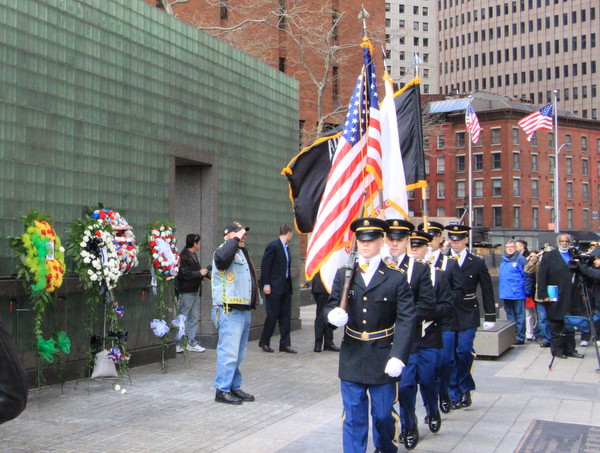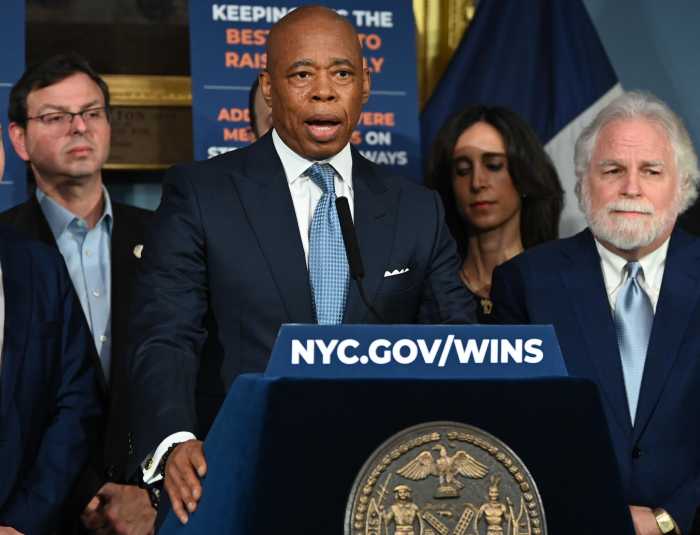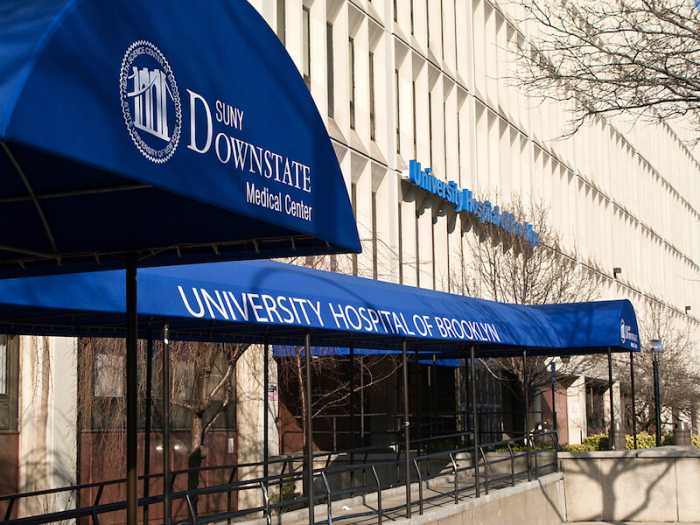
An Honor Guard of Fordham University R.O.T.C. cadets paid tribute March 23 to the 1,741 New York City troops killed in the Vietnam War.
By KAITLYN MEADE | Flowers bloomed at the Vietnam Veterans Memorial Plaza for the first time since Hurricane Sandy, just in time for the laying of flowers at the city’s Third Annual Vietnam Veterans Recognition Day in Lower Manhattan March 23.
Hundreds of veterans and families gathered at 55 Water St. for the ceremony, which included reading the 1,741 names of New York City soldiers who lost their lives during the war — a remembrance of those that were lost and a reminder to honor survivors whose welcome home was long overdue.
The names are also written on plaques along the “Walk of Honor” on the memorial’s plaza, which marked the height of the floodwaters last October as Hurricane Sandy roared into the Financial District.
“This is the only place where this exists,” said Vince McGowan, founding member of the United War Veterans Council and board member of Friends of the Vietnam Veterans Plaza.
The council and Friends group have been working to restore the memorial and 90,000 square foot public space, which suffered extensive damage from Sandy.
“We lost all the electric, all the lights in the ground, all of the trees and flowers, and one flagpole,” said Scott Bridgwood, who is handling most of the repairs. While the original memorial — a glass wall etched with letters donated by friends and family members of Vietnam vets — is still intact, its interior lighting has been damaged, making the letters hard to read. All of the underground lighting that illuminates the plaza must also be replaced.
The beds which once held trees, bushes and 17,000 tulips, are now mostly barren. Some of the usable beds were planted with pansies “to freshen them up” for the Saturday event, said McGowan, who until recently was an executive with the Battery Park City Parks Conservancy. He is “optimistic that nature will take care of itself” and bring back the rose bushes, “but the trees are gone.”
One of the hardest hit areas was the circular bed closest to the water which held spruce trees and bushes. The memorial’s Friends group is working with Rubicon to replace the soil, which was filled with contaminated saltwater, and hopes to have plants in the ground by the end of April and flourishing by the end of May.
Fundraising for the project has yet to begin but a FEMA application is pending for repairs, which McGowan says will cost $2.7 to $3 million.
McGowan, a Vietnam veteran, has helped rejuvenate the memorial before. In 1999, wear and weather had taken its toll since the memorial’s original dedication in 1985 by late Mayor Ed Koch and the NYC Vietnam Veterans Memorial Commission.
The Friends group formed and raised $7.1 million for renovation, starting in 1999.
“We were in the process of completion during 9/11,” McGowan recalled. “At the time, the smoke was still rising off the pile.”
Fang Wong, the first Asian-American to be elected national commander of the mutual-aid organization, the American Legion, said the memorial “serves to remind people that there are many heroes, many warriors out there fighting for their country… After 40 years, when we went back to Iraq and Afghanistan, we were facing the same thing. But people, the citizens, learned from the last time and supported [the returning soldiers].”
Wong, a Chinese immigrant and Vietnam Vet who grew up in Harlem and Chinatown, retired from the Army in 1989 and joined the American Legion’s Lt. B.R. Kimlau Post 1291, based out of Canal St.
After 9/11, Post 1291 played a role in Chinatown’s recovery efforts and supported returning veterans from Iraq and Afghanistan.
Turning back from the memorial to look at the gathering of veterans, Wong said, “To be able to see it and absorb and receive appreciation from others, even their peers… it’s a positive feeling. It’s a healing process for some of them, even now.”





































